After some huge leaks, GoPro has finally taken the wraps off its new HERO4 as it throws the gauntlet down again to make a statement as the clear leader in the action camera market with the HERO4 Black Edition.
There are, in total, three new cameras:
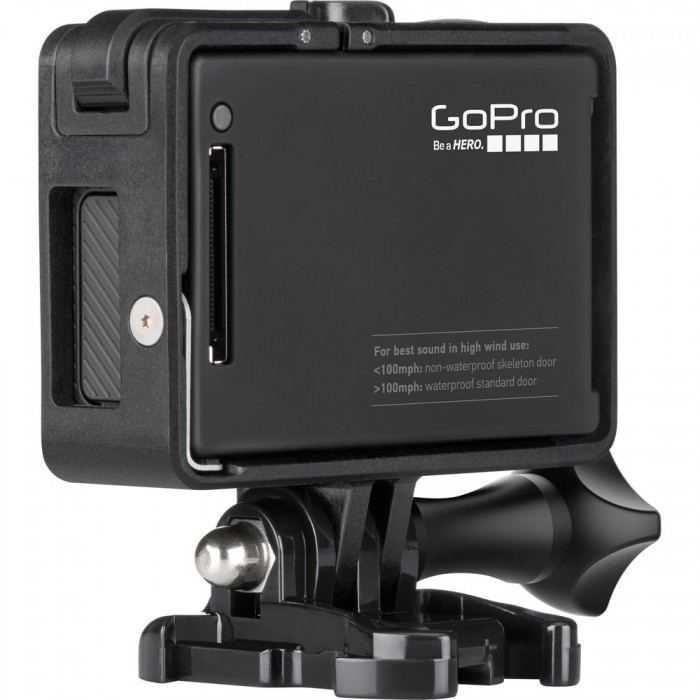
GoPro HERO4 Black
The HERO4 Black Edition has a couple of big resolution feature bumps. It shoots 4K video at 30fps, 2.7K at 50fps and 1080p video at 120fps.
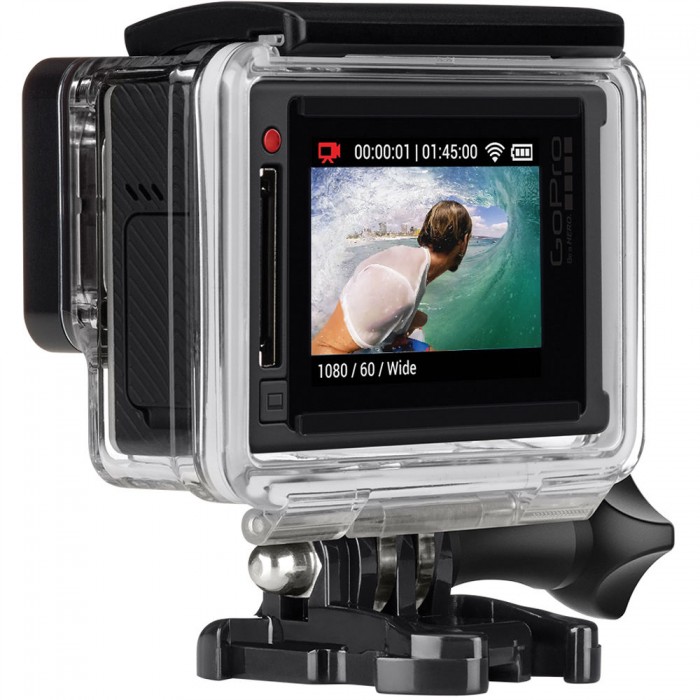
GoPro HERO4 Silver
The HERO4 Silver Edition is a little lower spec’d in the resolution and frame rate department, but still offers 2.7K at 30fps, 1080p at 60fps and 720p at 120fps. However, the Silver Edition adds a built-in touch screen display on the back of the camera.
The HERO4 Silver’s touch screen reported sips battery life because it shuts off after a few seconds of non-use. You tap the display again to wake it up.
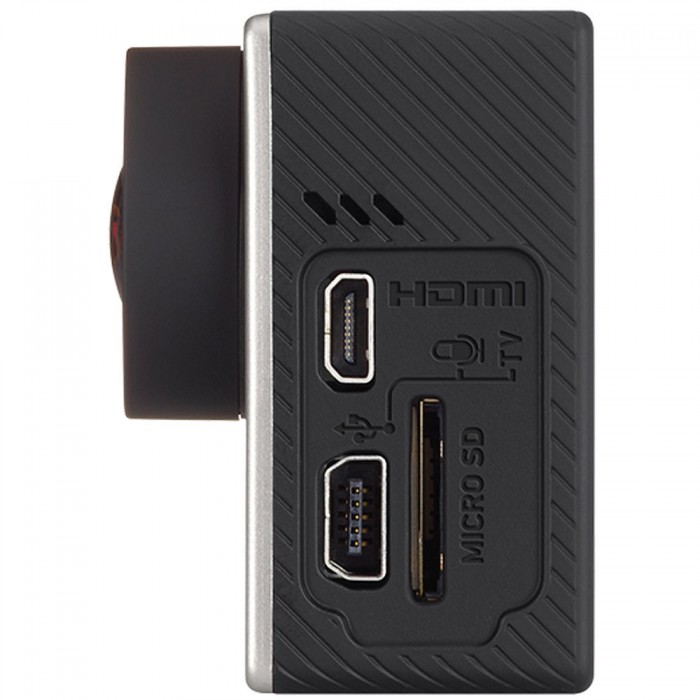
GoPro HERO4 Black
Both new models offer faster WiFi combined with Bluetooth for better performance and power management. Additionally, both models share the following new features per GoPro’s press release:
- Protune™, now for photo + video.
For those who prefer to take manual control of their GoPro to maximize versatility and performance, we’ve expanded our professionally minded Protune mode to include Color, Sharpness, ISO Limit, and Exposure controls for both photo and video capture. - New settings for after dark.
Whether you’re shooting the Milky Way or a campfire hangout, Night Photo and Night Lapse allow you to capture stunning images of ultra low-light scenes with customizable exposure settings of up to 30 seconds. - Mark your best moments.
HiLight Tag enables you to mark key moments with the push of an on-camera button while recording, making it easy to find, playback and share your favorite clips in GoPro Studio or with the GoPro App. You can also HiLight Tag using the mobile GoPro App or the new Smart Remote accessory. - QuikCapture speed and convenience.
QuikCapture makes it easy to power on and record with the press of a single button. When enabled, a single press starts video capture, while a press and hold engages Time Lapse photo capture. - High-performance audio.
A totally re-designed internal audio system combines with a state of the art microphone to capture clean, high fidelity sound with 2x the dynamic range of previous models.
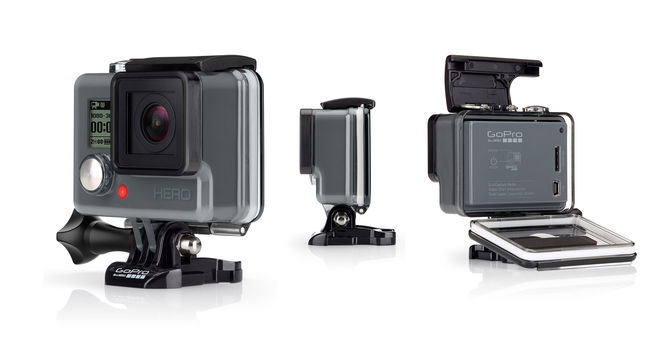
GoPro HERO
Alongside the new HERO4 models, the GoPro HERO is introduced as a low-end $129 action camera to round out the line. The basic HERO is a no-frills camera that captures 1080/30p and 720/60p video. It also captures 5MP photos and includes an integrated waterproof case. Check it out here at B&H Photo.
The HERO4 Black retails for $499.99 and should be available on October 5. Check it out here at B&H Photo.
The HERO4 Silver retails for $399.99. Check it out here at B&H Photo.
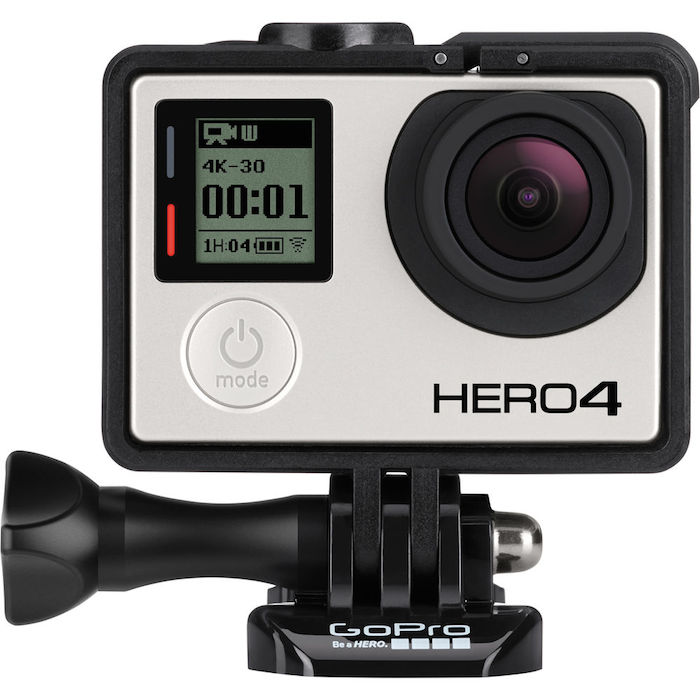


Massively disappointing:
no 1080p at 120fps
no mention of sharper optics
no mention of improved stabilization system
no mention of vastly improved battery life
At very best you would describe this as a tiny evolutionary step forward from 4k at 15fps to 4k at 30fps.
Yes i like the sound of an improved mic (pun totally intended) but again this is a small step and low light has always needed attention.
I would say that 90% of the GoPro target audience can only use high frame rate footage and so the 1080p at 60fps and 720p at 120fps options have not changed since the original GoPRo Hero 3 (not 3+) which was back in 2012.
“no 1080p at 120fps”
Actually, if you read the specs, the Hero4 Black Edition DOES indeed shoot 1080/120fps.
2x Faster Processor than HERO3+ Black Edition
The redesigned processor is twice as fast as the one in the HERO3+ Black Edition. This enables 4K30 recording as well as 2.7K recording at up to 120 fps, and 1080p slow-motion recording at 120 fps
OK i am really not sure what happened there, my bad!
1080p at 120fps is a nice feature, would have really liked 720p at 240fps too but i hear the sensor couldn’t do it.
Still feel the other points are valid though. If you look at Sony’s IS they are so far ahead:
http://youtu.be/ATmyUzAxQas
The reason Sony is far ahead is because they make GoPro’s sensor as well as most of the pro still camera sensors throughout the world.
72 Billion in revenue last year!
I believe they make the sensors for Nikon stuff but most would agree Nikon SLRs are better than Sony’s so it’s not impossible to put do the parent manufacturer.
While we are on the subject, anyone know who makes the 41mp sensor for the Nokia phones?
Also no mention of H.265 compression (HEVC) which would keep file sizes in check and also allow slower, cheaper cards to still be used.
There are no editing systems that are currently supporting H.265 for NATIVE editing. Until this part of the equation is addressed by ANY of the major players, I doubt you’ll see a company that has a large consumer-base (like GoPro) take on recording to H.265 for a flagship product.
GoPro’s CineForm codec is phenomenal, so I guess transcoding everything shot would be an option, but that’s adding an extra step in the process… That is not the way the video industry is heading now – native editing and workflows are becoming “standard” for most major software and this is trickling down to the consumer-based editing software as well.
I take your point on board but what kind of bit rates are being used for 4k 30fps and 1080p 120fps?
To maintain the frame quality of Hero3 which was 45Mbs for 1080p at 60fps they will have to record at 90Mbs for 1080p at 120fps which i am betting they don’t offer.
Where as if H.265 was an ‘option’ it would add some future proofing and allow for cheap MicroSD cards to still capture high quality results while we wait for software companies to catch up.
Things like this are always a chicken and egg scenario though, why would a software company support a format that no products are using? Why would a manufacturer make a product that can’t be edited on any software?
Software editing companies like Adobe and Avid are about a year out from H265 support last I knew. Part of that is due to OS restrictions and waiting for better integration, the other part is the codec support. Last I read there was one company offering software encoding/decoding and it wasn’t a “major” player yet. Until even a MainConcept style company can offer at least Windows support then choices with H265 will be limited.
Why would GoPro lead the H265 education movement on top of the hurdles needed to just bring support for paid users, most of whom are consumers (non-professionals)? From a business stand point it doesn’t make sense right now. Samsung wouldn’t even let the footage from their new cameras out of their sight yet because there’s no editing support for it. They knew their product would be DOA because the Internet would have blown up with “the footage doesn’t work” style complaints.
Read some video focused blogs like EOS HD and you’ll learn a bit more about the current hurdles.
H265 is fantastic. And for 4K it’ll be great for acquisition and distribution… Once support is in place.
GoPro is great with firmware updates so if the black edition is capable, they will update it at some point. In the meantime, they’re basically going the GH4 route and requiring high speed cards for the highest bitrates. They aren’t cheap, but starting to become more available, so maybe in 3-4 months we can get “deals” at similar prices to current crop of class 10 carda?
GoPro is now selling two brands of micro sdhc cards, so hopefully that’s a sign of better support and firmware guarantees moving forward. Blackmagic is notorious for dropped frames with “non supported” SSD drives and I actually applaud GoPro by addressing the concerns/issues with firmware data limited for non-supported cards. Dropped frames and corrupt files are worse than compression artifact from lower bitrates…